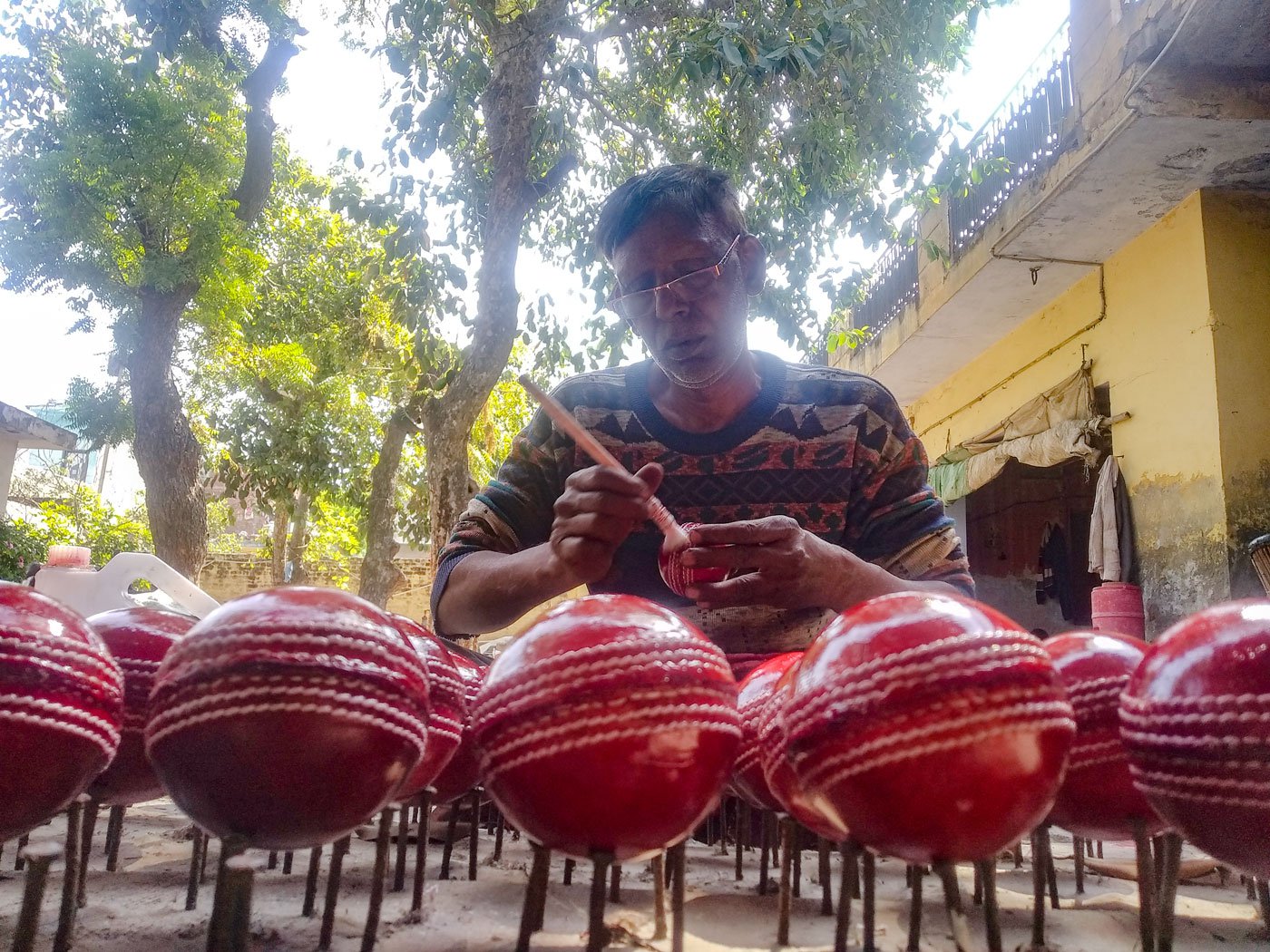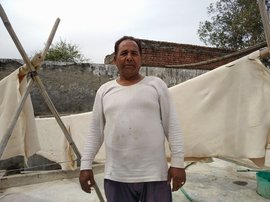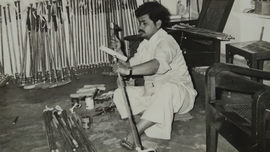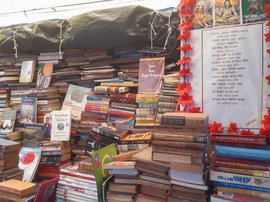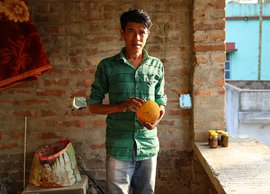“How does it matter who wins? Or whether it is the IPL or World Cup?”
In a country where cricket is almost a religion, Madan’s question is profane.
But he follows it up saying, “ Koi bhi jeete, humein kaam mil jata hai [whoever wins, we get work].” Madan, 51, is a maker of cricket balls and owns one of many units rolling out shiny red and white balls in Meerut city.
It’s the month of March and he is surrounded by about 100 boxes, each containing six leather balls, ready to be played in the packed men’s cricket calendar. The first ball of the season is bowled at the end of March for the Indian Premier League (IPL) that lasts two months. It is followed by the ICC World Test Championship Finals in June. Coming up, India will be hosting the One Day International (ODI) World Cup in October and November.
“At what level the ball will be used, who will play with the ball, the number of overs it will be played for, will be determined by the [ball’s] quality,” Madan says.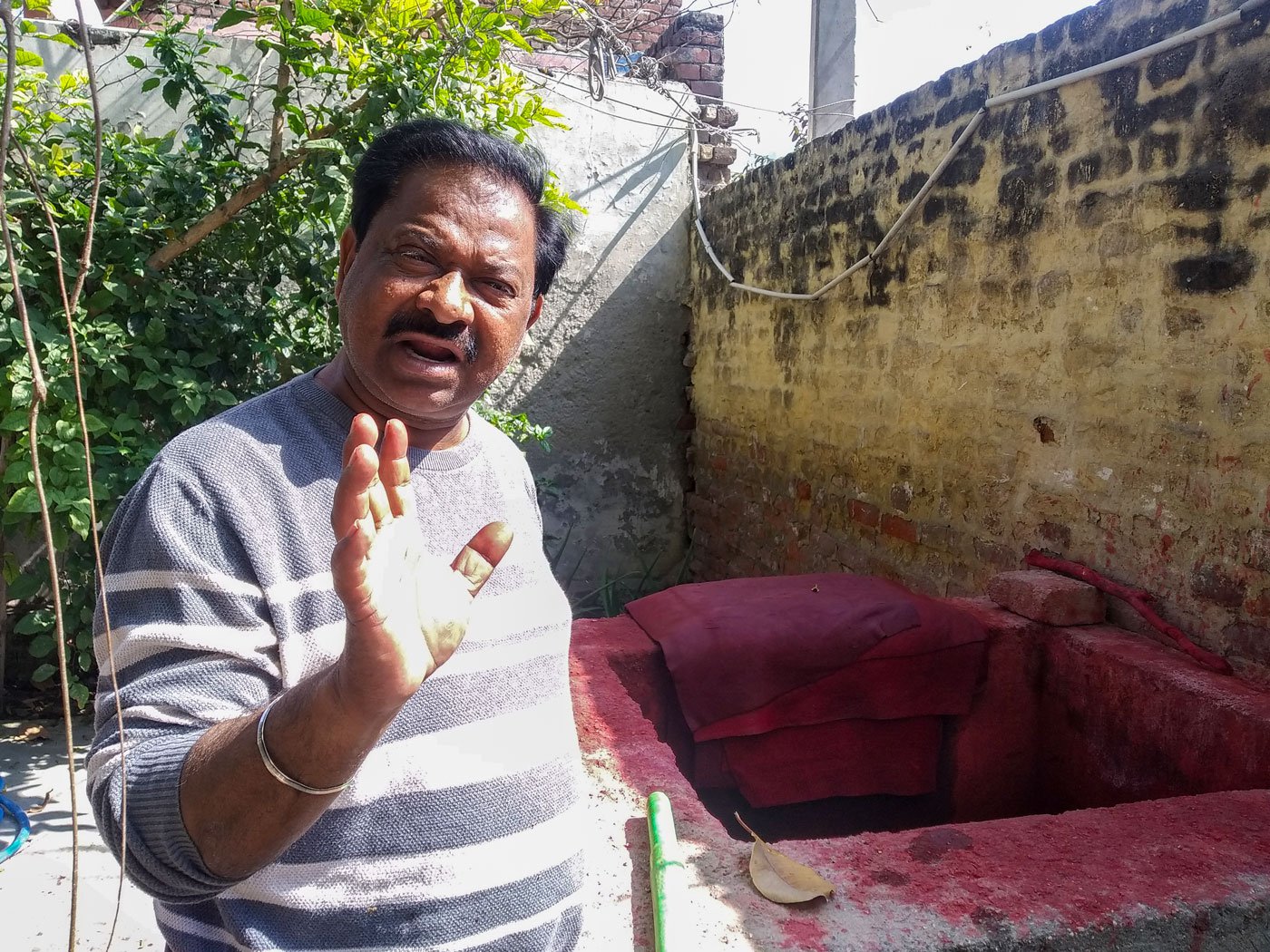
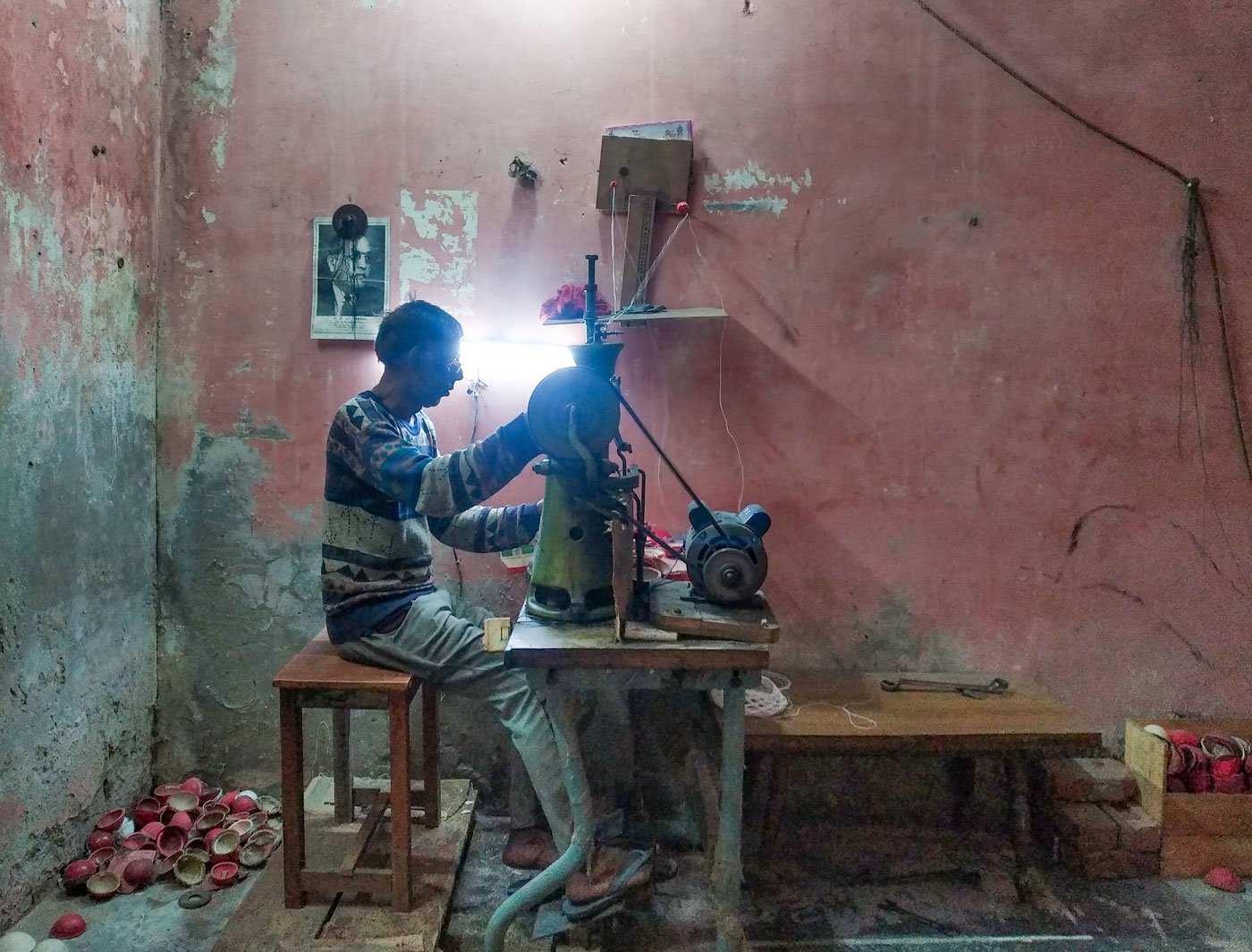
Madan (left) at his cricket-ball-making unit in Shobhapur slum of Meerut district. Dharam Singh (right) is the most experienced craftsperson at Madan’s unit. Most of the artisans are Jatavs and follow Dr. Ambedkar
“Before big tournaments, sports goods retailers and wholesalers reach out to us well in advance,” he says, underlining the national obsession with the game. “Demand increases hugely two months before, and shops in big cities want to stock up on balls for the right moment.” Prices range between Rs. 250 all the way to Rs. 3,500 depending on who is playing and how much is riding on it.
Madan gets direct orders from cricket academies, distributors and retailers in Mumbai, Ahmedabad, Baroda, Jaipur, Bengaluru and Pune. The balls manufactured at his unit here are used at lower levels of the game for practice and matches.
We are in his workshop and a live cricket match is showing on a tiny curved-display TV. The screen is tilted towards a silent audience of eight
karigars
(craftspersons). But they can only afford to listen, their eyes are on their work: “
Humein abhi bilkul fursat nahi hai
[We have absolutely no time to spare]
,
” says Madan.
They are bending over iron clamps, undertaking tedious stitching routines for an order of 600 medium quality two-piece cricket balls. The buyer is from the union-territory of Jammu and Kashmir and needs this delivery in three days.
Madan picks up one of the shiny red balls, ready to be shipped. “Three ingredients go into making a ball. Alum-tanned hide for the cover, inner core [ gola ] made of cork, and cotton thread for stitching.” All three are locally available in Meerut district and, “once a buyer tells us their quality requirement, we choose the leather and the cork accordingly.”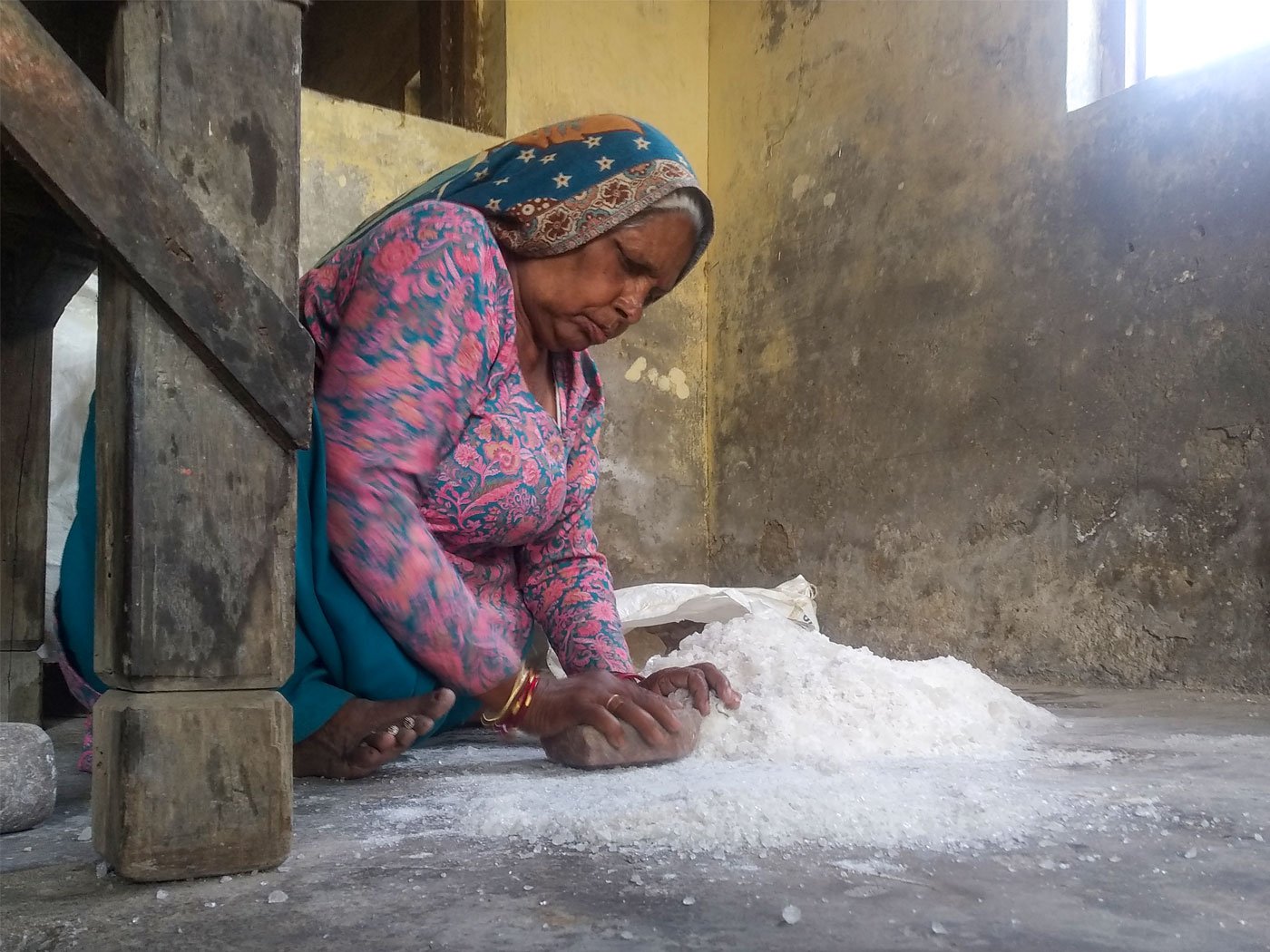
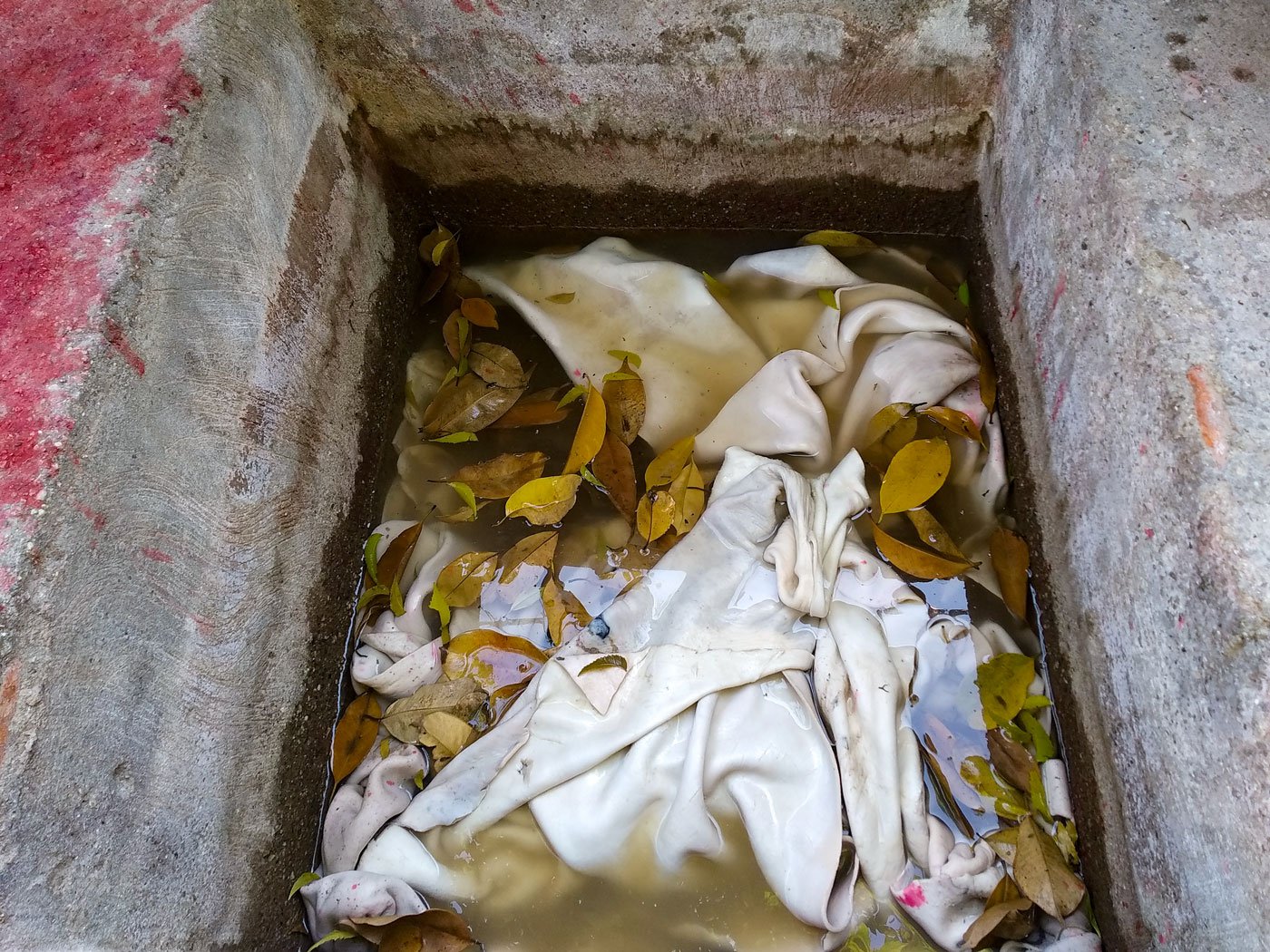
Women are rarely formally employed here, and Samantara comes in to work only when Madan’s unit gets big orders. She is grounding alum crystals that will be used to process leather hides (on the right). These hides are soaked for three days in water mixed with baking soda, alum, and salt to make them soft and amenable to colour
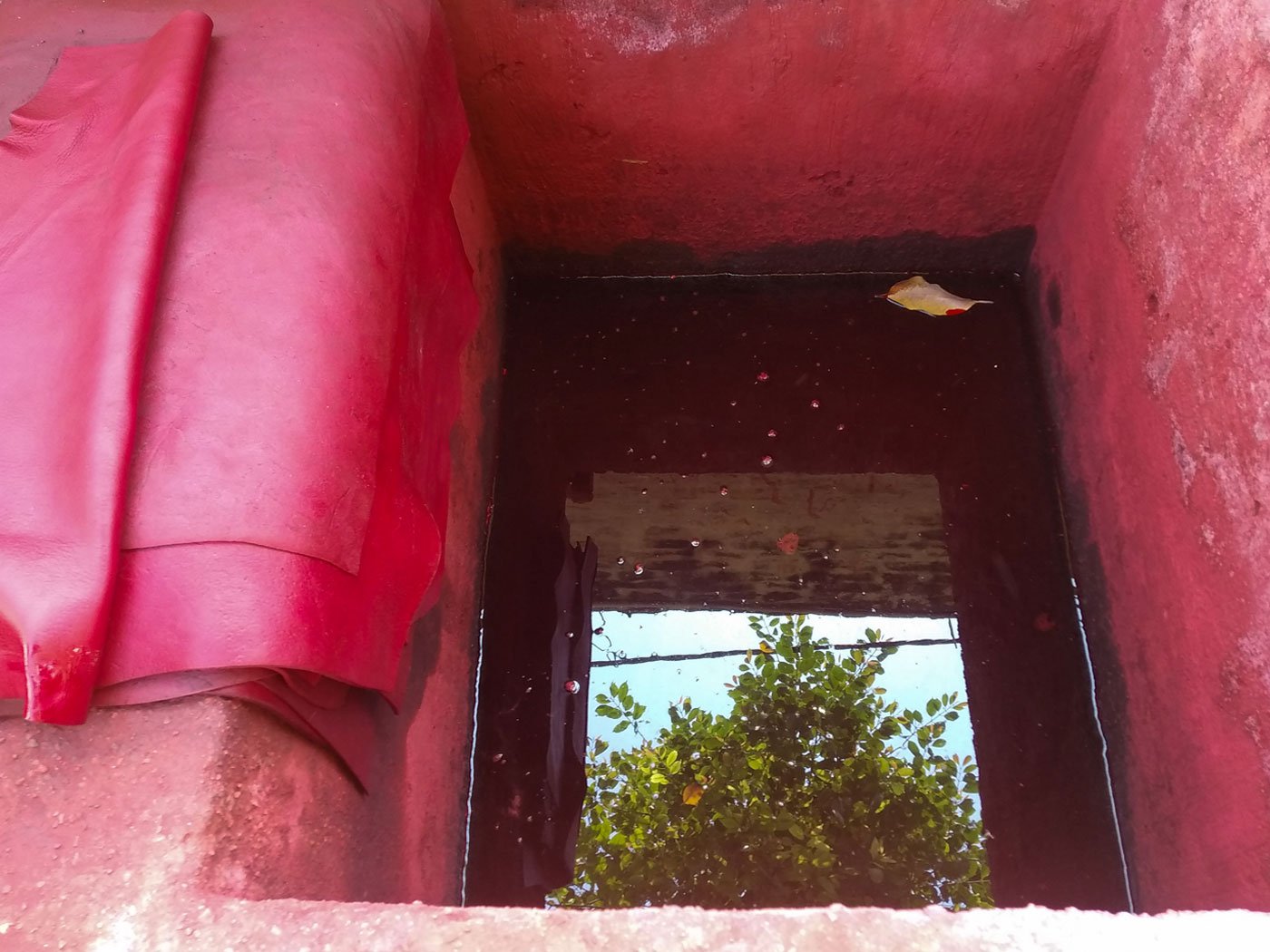
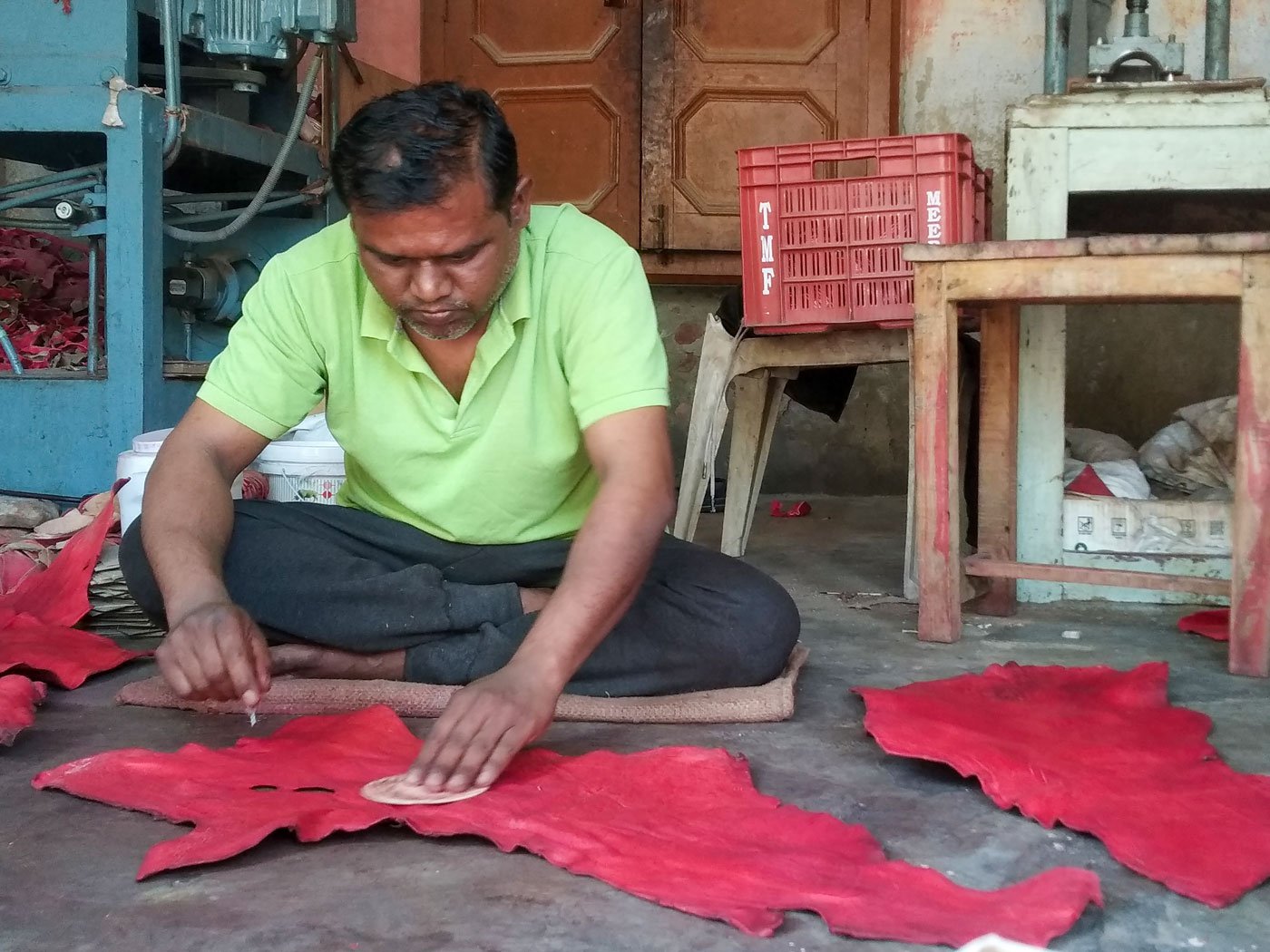
Workers dye the leather red (left) and make cricket balls using two or four pieces of leather. Sachin, 35, (right) cuts the leather in circles for two-piece balls
The District Industry Promotion and Entrepreneur Development Centre (DIPEDC) estimates that there are 347 working cricket-ball-making units in Meerut. The number includes large factories located in industrial areas; and smaller production units in urban and rural residential localities in Meerut district.
The estimate, however, does not include numerous dispersed unorganized production centres, and household units where entire balls are made or a singular task is outsourced. These include villages like Jangethi, Gagaul and Bhawanpur located across Meerut district. “ Aaj gaanvon ke bina bilkul poorti nahi hogi Meerut mein [There will be absolutely no supply of cricket balls without the villages in Meerut today],” Madan says.
“A majority of
karigars
in villages and big factories in the city are Jatavas, as cricket balls are made of leather,” he explains. According to the 1904 District Gazetteer, the Jatava or Chamar community (listed as Scheduled Caste in UP) constituted the largest social group of workers in the leather industry in Meerut. “People do not have a problem with leather in the form of a cricket ball, but they do when it comes to working with it,” he adds.
His family owns a tannery in Shobhapur as well, the only locality where rawhide is alum-tanned for the cricket ball industry (Read: Meerut's leather workers: not out, still batting ). “Seeing the increasing demand for alum-tanned hides, I realised that the demand for cricket balls will never go down,” he says. The promising market led him to start M/s B.D. & Sons, 20 years ago – one of the two cricket-ball-making units in the locality.
Madan says it’s difficult to accurately estimate the number of hours that go into making a single ball since the many processes are shared, and the season and quality of leather also impact the time it takes. “ Do hafte lagte hain ek gend ko tayyar hone mein kam se kam [It takes upto two weeks to get a single ball ready],” he says.
Workers at Madan’s unit first process the leather with alum, dye it red, dry it under the sun, grease it with tallow or animal fat and then stomp it with a wooden hammer to make it soft. “For white balls, no dyeing is required as alum-tanned hides are already white. Curd made of cow’s milk is used as grease for them,” says Madan.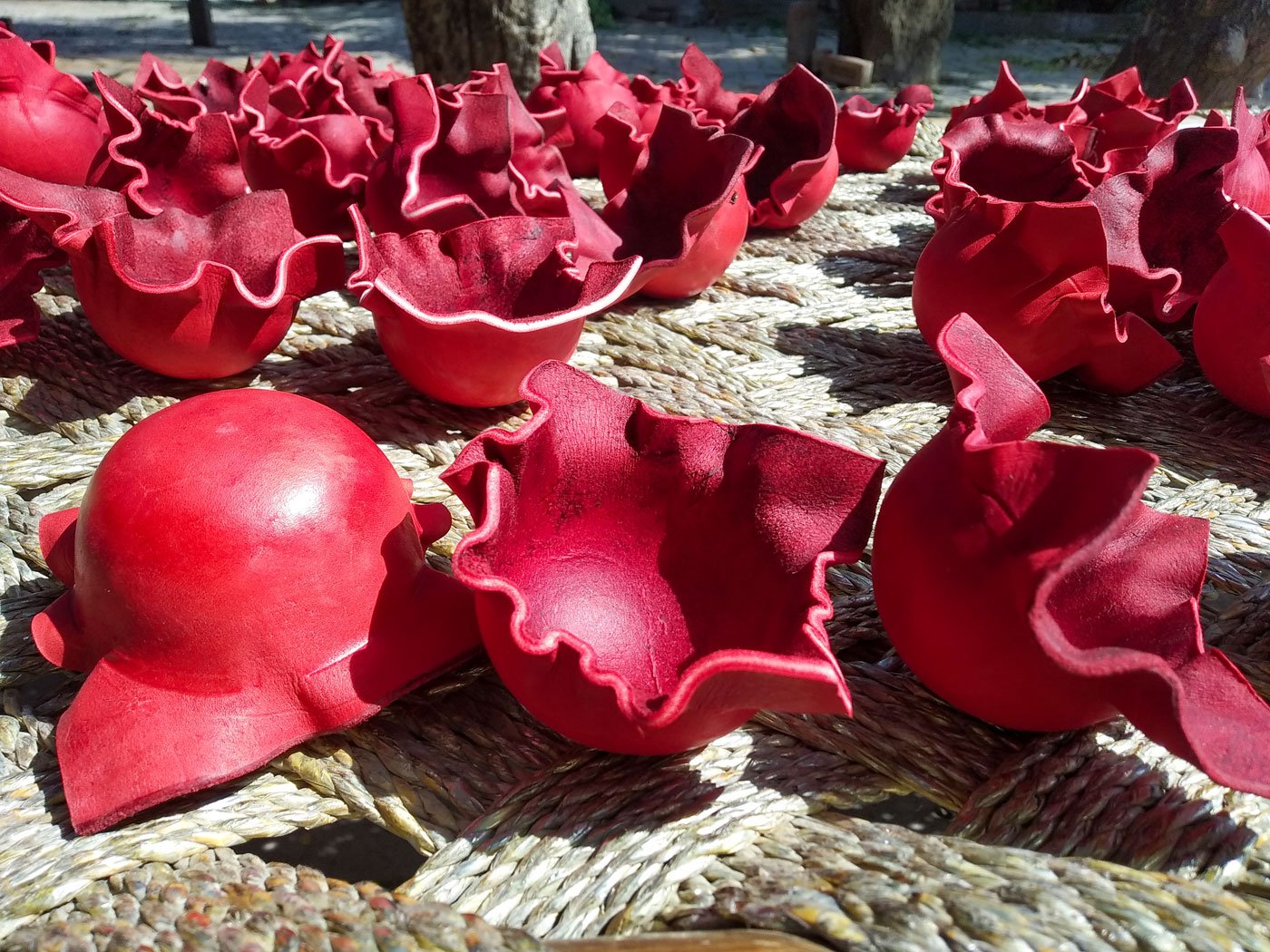
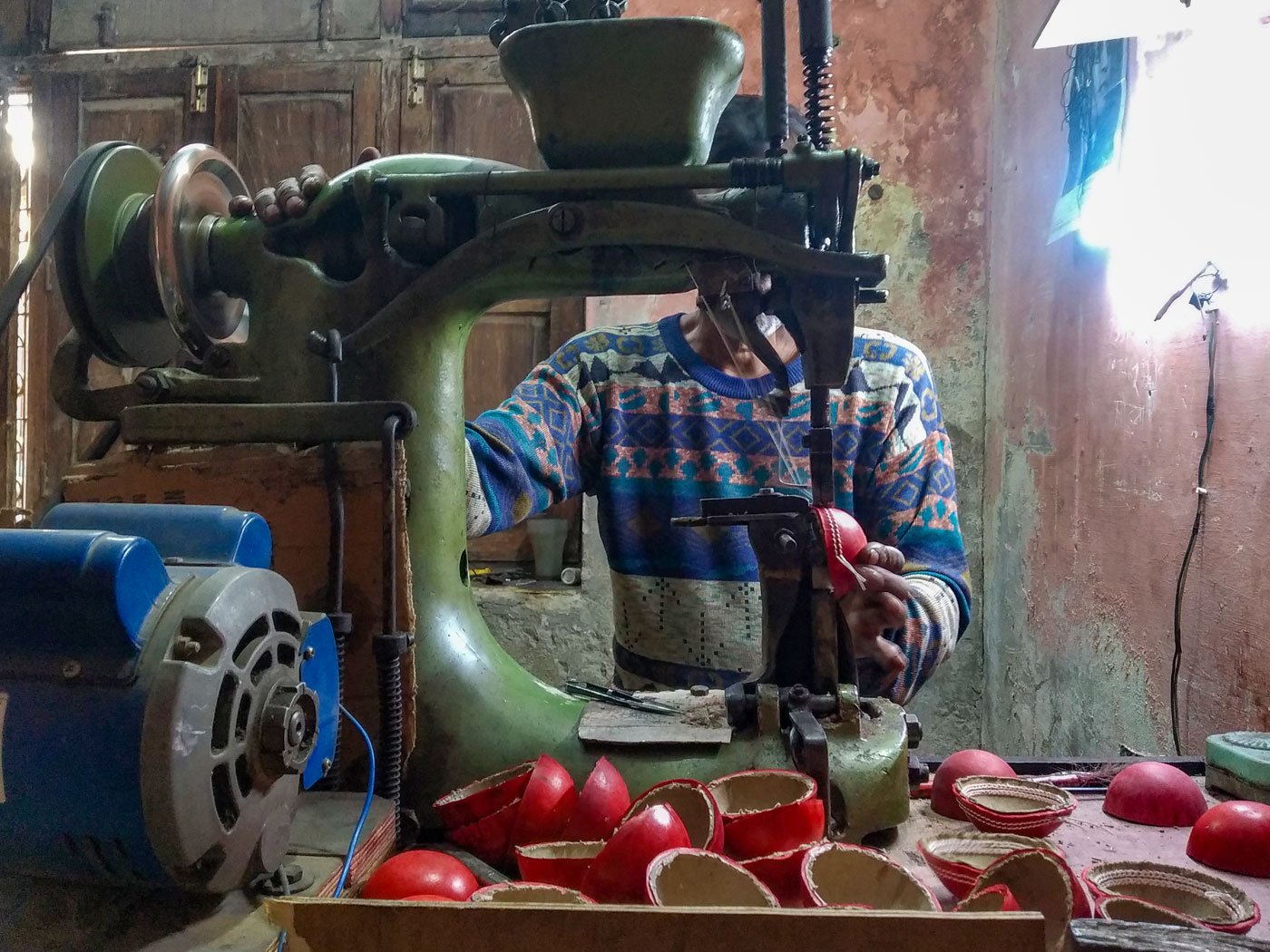
Left: Heat-pressed hemispheres for two-piece balls are left to dry in the sun. Right: Dharam uses a machine to stitch two parallel layers of seam on each of these hemispheres. Unlike a handstitched seam in the case of a four-piece ball, a machine-stitched seam is purely decorative
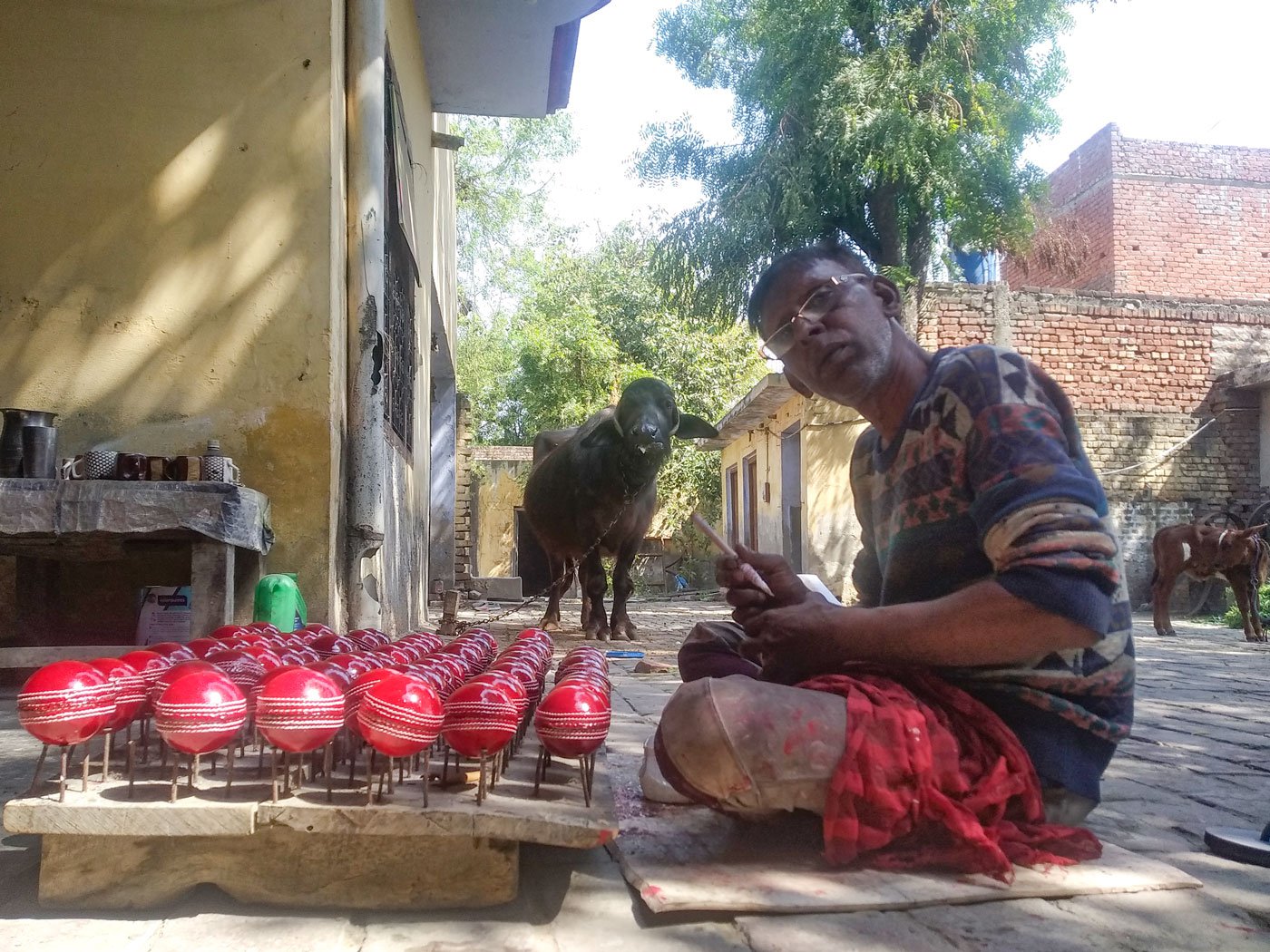

Left: Dharam puts lacquer on finished balls to protect the leather from wearing out. Right: Gold and silver foil-stamped cricket balls at a sports goods retail shop in Dhobi Talao, Mumbai. These have been made in different ball-making units in Meerut
“ Line se kaam hove hai aur ek karigar ek hi kaam kare hai [The tasks are sequential and a craftsperson specialises only in one task],” he explains. The assigned karigar then cuts the leather either into two circular pieces, or four oval quarters. Cricket balls are made of two pieces or four pieces of leather.
“The pieces should be of the same thickness and have similar hair grains,” Madan says. “ Iss waqt chhantne mein galti ho gayi toh samajhlo ki gend deshape hoga hi [If a mistake is made in segregating at this stage, the ball will definitely lose its shape],” he adds.
The most skilled task in the physically demanding process of ball-making is the craft of hand-stitching the leather with cotton threads that have pig bristles attached as ends. “Bristles instead of needles are used because they are flexible, strong and not sharp enough to tear the leather,” says Madan. “They are long, easier to hold and do not puncture the stitcher's fingers as well.”
“ Lekin sirf issi cheez ki wajah se hamare Musalman bhai yeh kaam nahi kar sakte. Unko suar se diqqat hoti hai na [But our Muslim brothers cannot take up ball-making only because of the usage of pig bristles. They do not like pigs],” he adds.
“It takes many years to master the craft of the three types of stitches that go into making a four-piece ball,” says Dharam Singh, the most experienced ball maker in Madan’s unit. The 50-year-old is applying varnish on balls as part of the Jammu-Kashmir’s client’s order. He says, “as a karigar moves upwards from one type of stitch to another, the piece wage also increases.” Each progressing stitch is a different technique and serves a distinct function.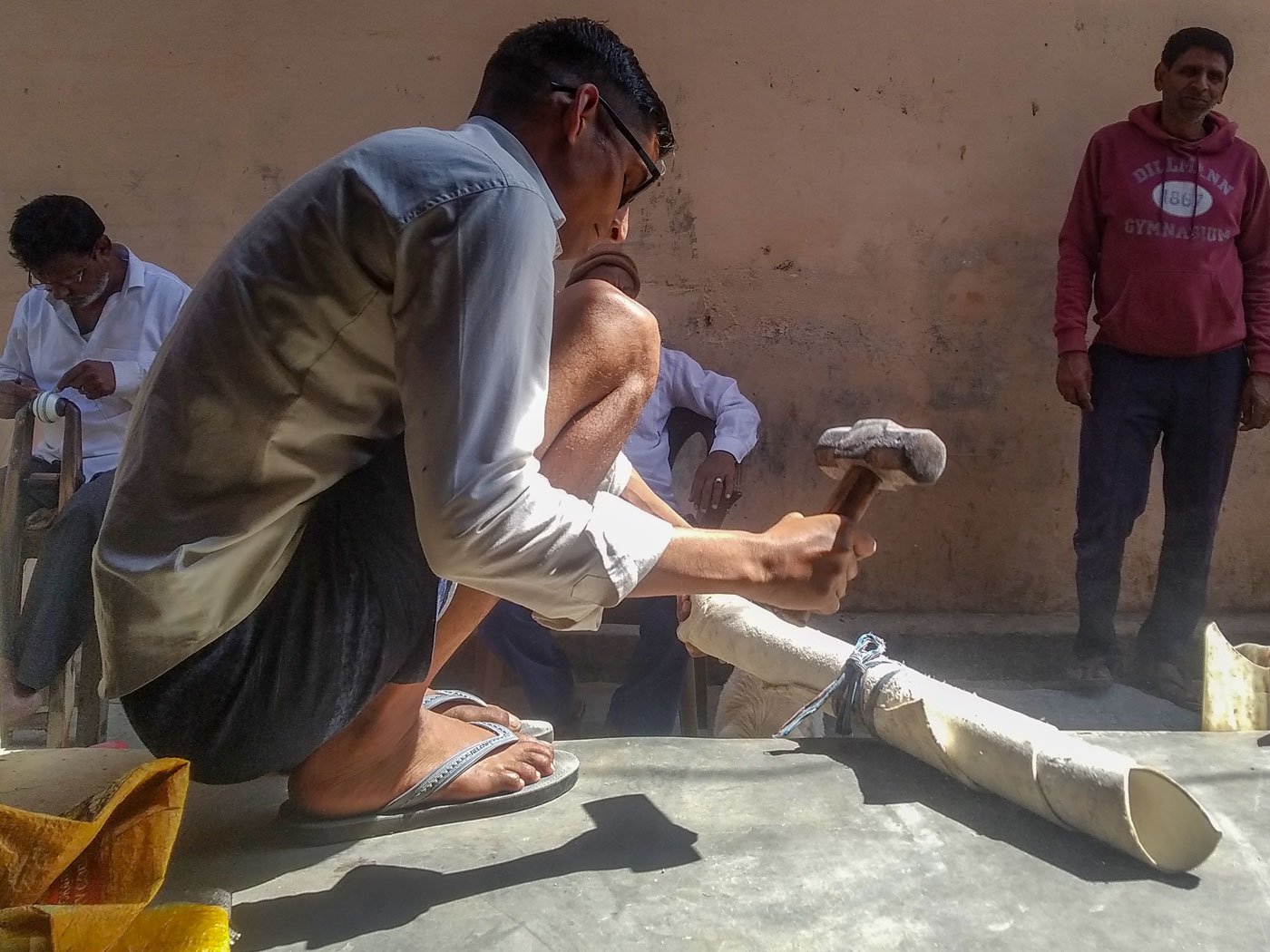
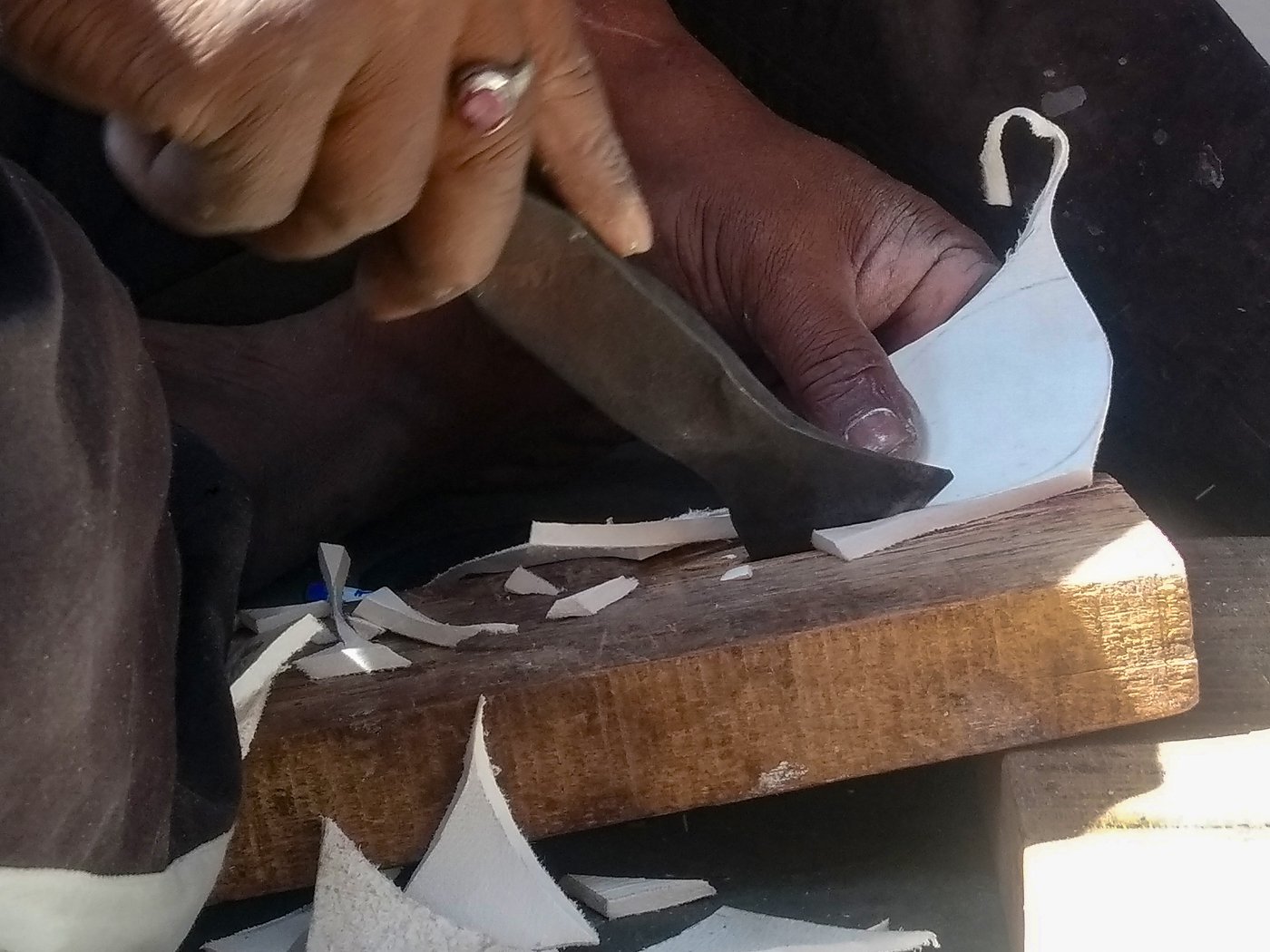
Sunil (left) beats a roll of processed leather with a hammer to make it pliable, a step locals call
melli maarna
.
For four-piece balls, leather is cut (right) into oval pieces that will make four quarters of a ball
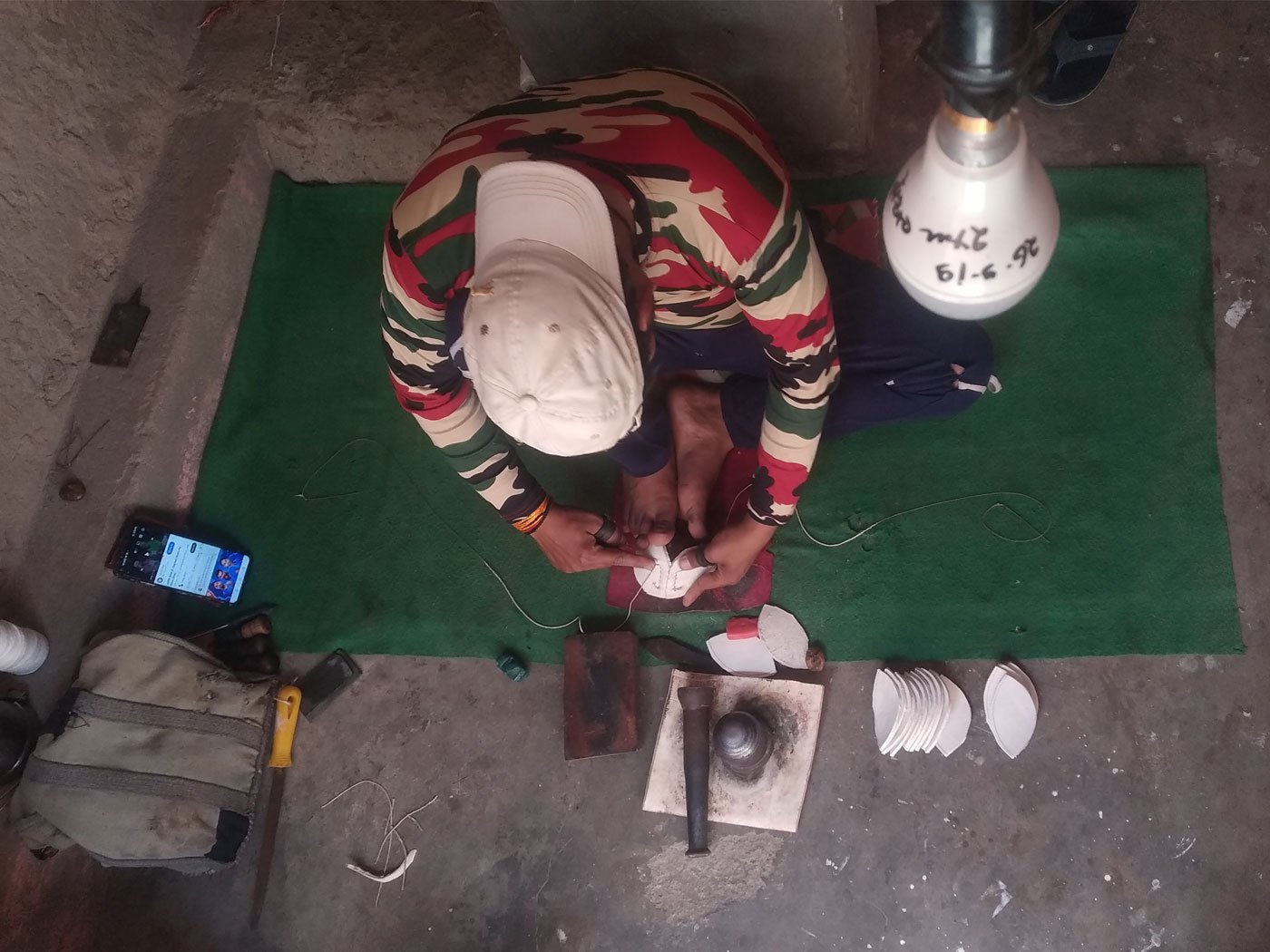
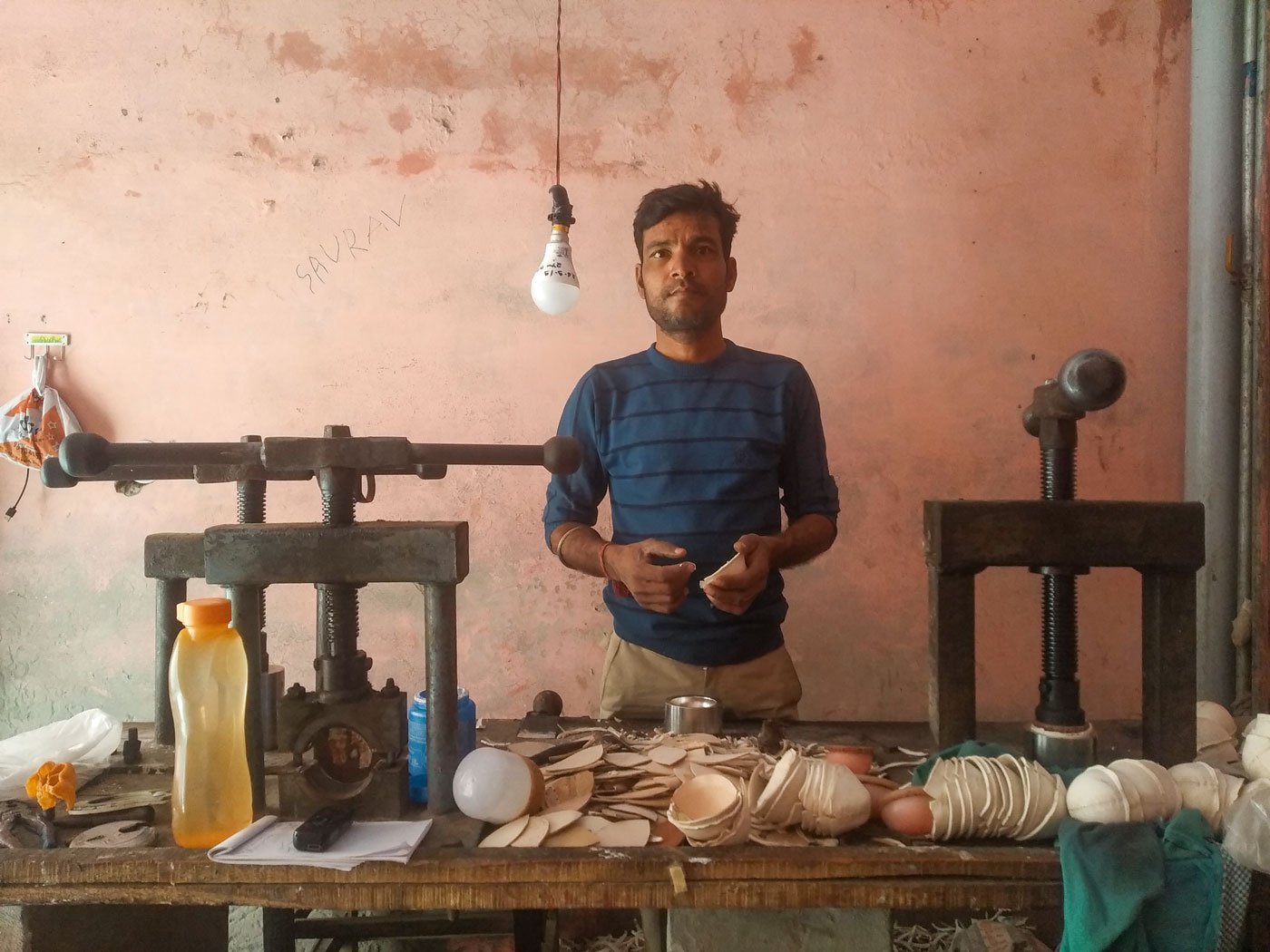
Left: Monu joins two oval pieces to make a cup or hemisphere and then makes holes using a tool called aar . Right: Vikramjeet reinforces the inside of the hemispheres with thinner, oval pieces, a process known as astar lagana . The machine on his right is used for seam-pressing, and the one on his left is the golai (rounding) machine
First, two oval pieces of leather are joined by inner stitching to make a hemisphere or cup, locally called piece judaai . The first stitch is usually done by a beginner, who earns Rs. 7.50 for each hemisphere. “After piece judaai the cups are reinforced with thinner leather pieces called lappe , ” explains Dharam. The cushioned leather hemispheres are then shaped in a mould to a definite round with a golai (rounding) machine.
Workers join the two hemispheres with simultaneous stitches from both sides with a compressed rounded cork in between to make a ball, known as cup judaai. The wage for cup judaai ranges between Rs. 17-19. Two-piece balls also undergo cup judaai hand stitching.
“It is only after the second stitching is complete, the word ball [ gend ] is used , ” Dharam says, “ pehli baar chamra ek gend ka aakar leta hai [this is the first instance at which leather takes the shape of a ball].
Dharam learnt the craft of ball making about 35 years ago in a factory on Suraj Kund Road, where sports goods began to be manufactured in the 1950s. After partition, the sports goods industry was established by displaced persons from Sialkot (now in Pakistan) who were rehabilitated in sports colonies around Suraj Kund Road and Victoria Park in Meerut. “People from villages around Meerut went to the city, learnt the craft, and brought it back.”
The third stage of stitching is the most crucial for a four-piece ball. It requires four parallel rows of seam (
gend silai
) to be intricately crafted on the ball. “The best balls have around 80 stitches,” he says. Depending on the number of stitches, a worker earns between Rs. 35-50 per ball. For two-piece balls, the seam is machine-stitched.
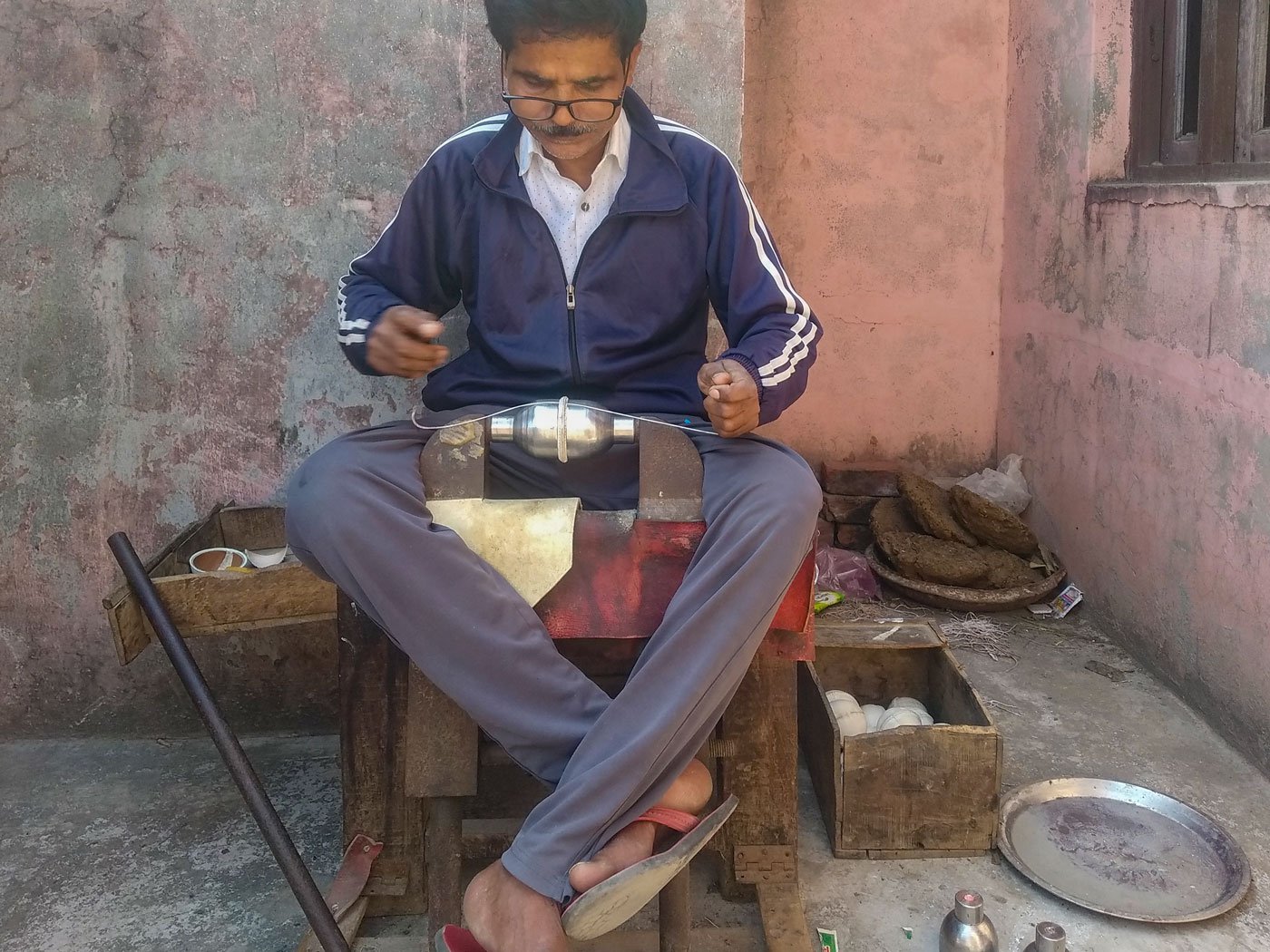
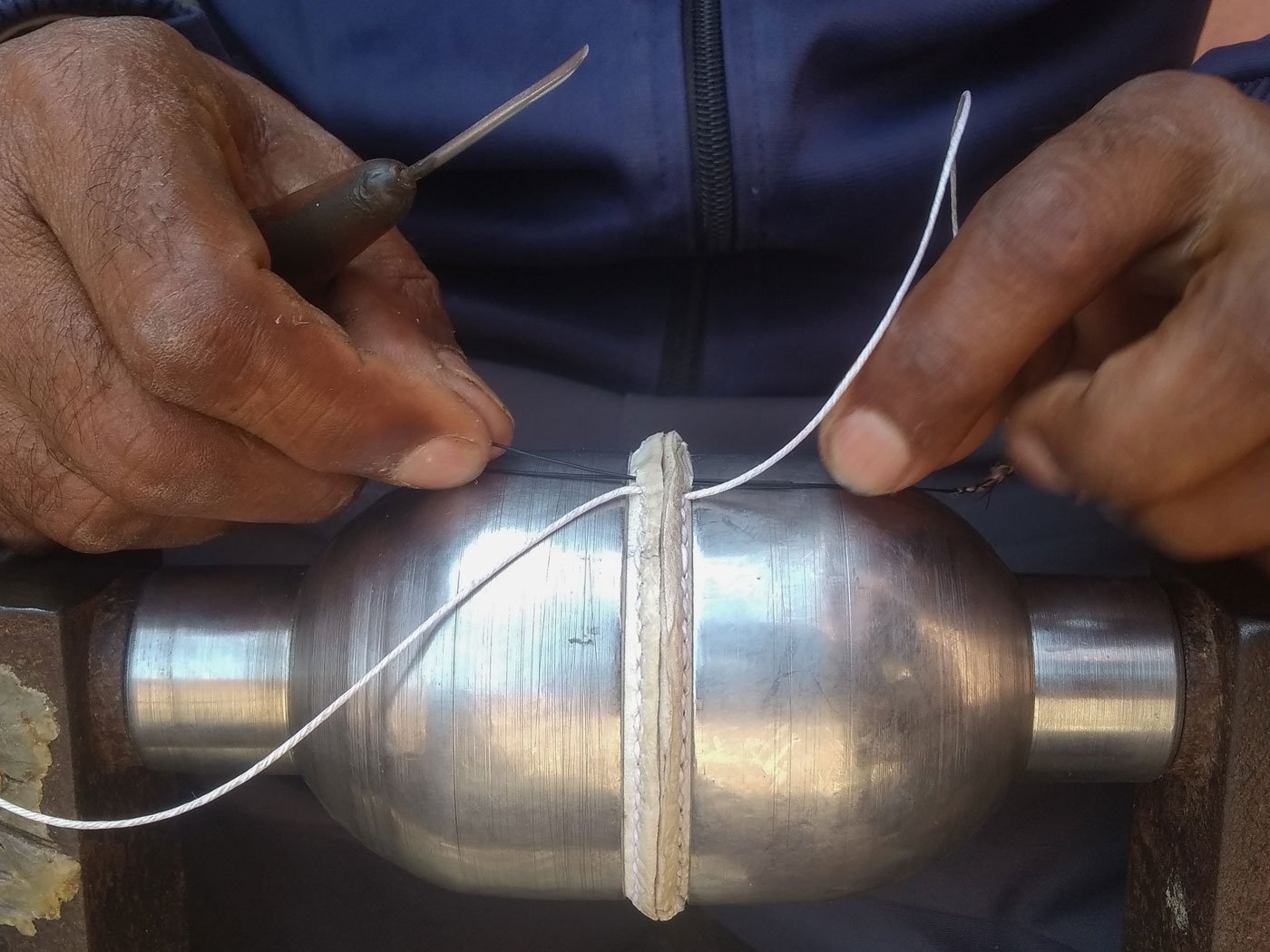
Bharat Bhushan using an aar to make insertions through the leather that protrudes between the two hemispheres, held together by an iron clamp. He places a rounded cork between the two cups and attaches pig bristles by their roots to the ends of a metre-long cotton thread for the second stage of stitching. He then inserts the two pig bristles through the same holes from opposite directions to stitch the cups into a ball
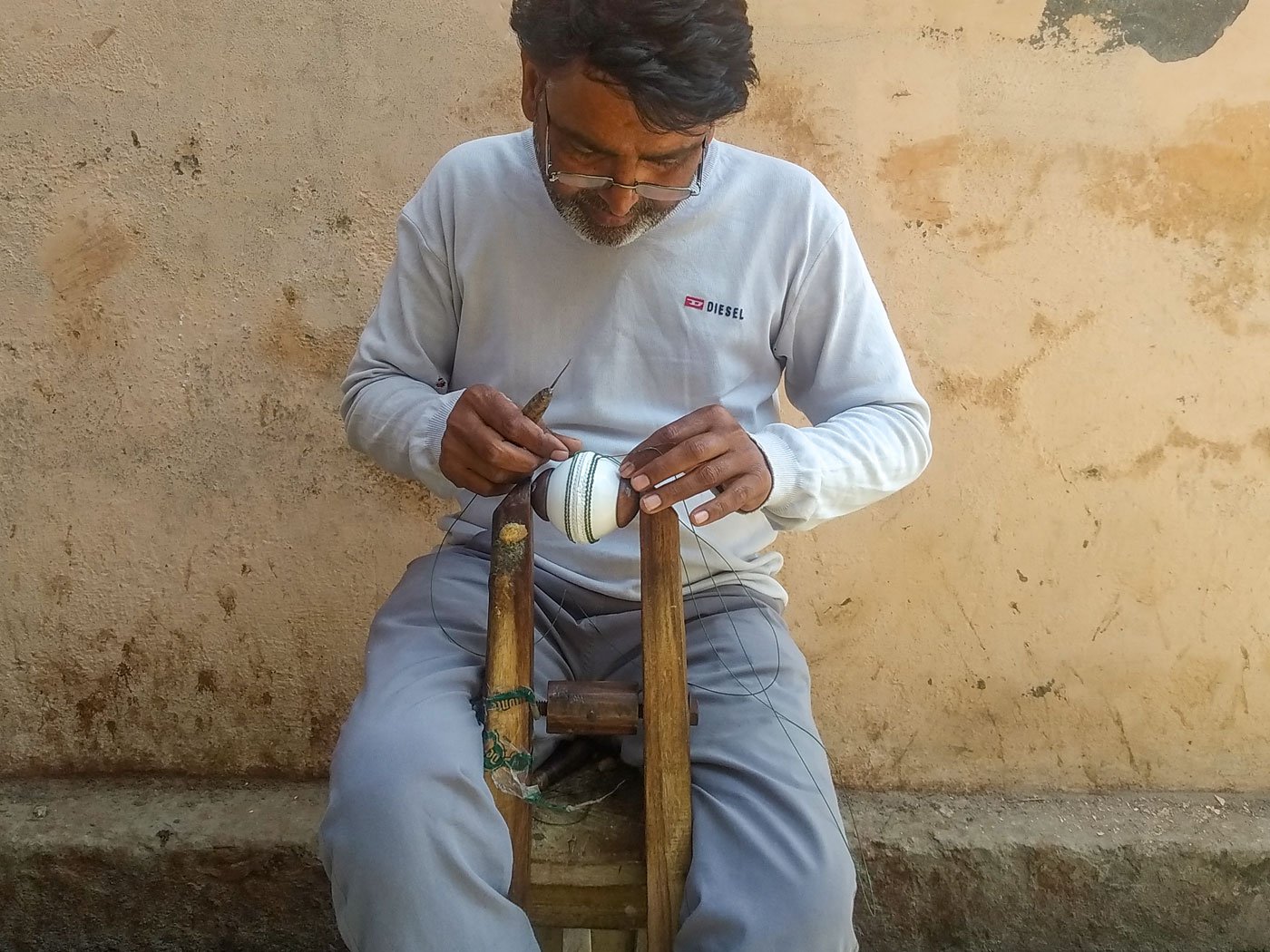
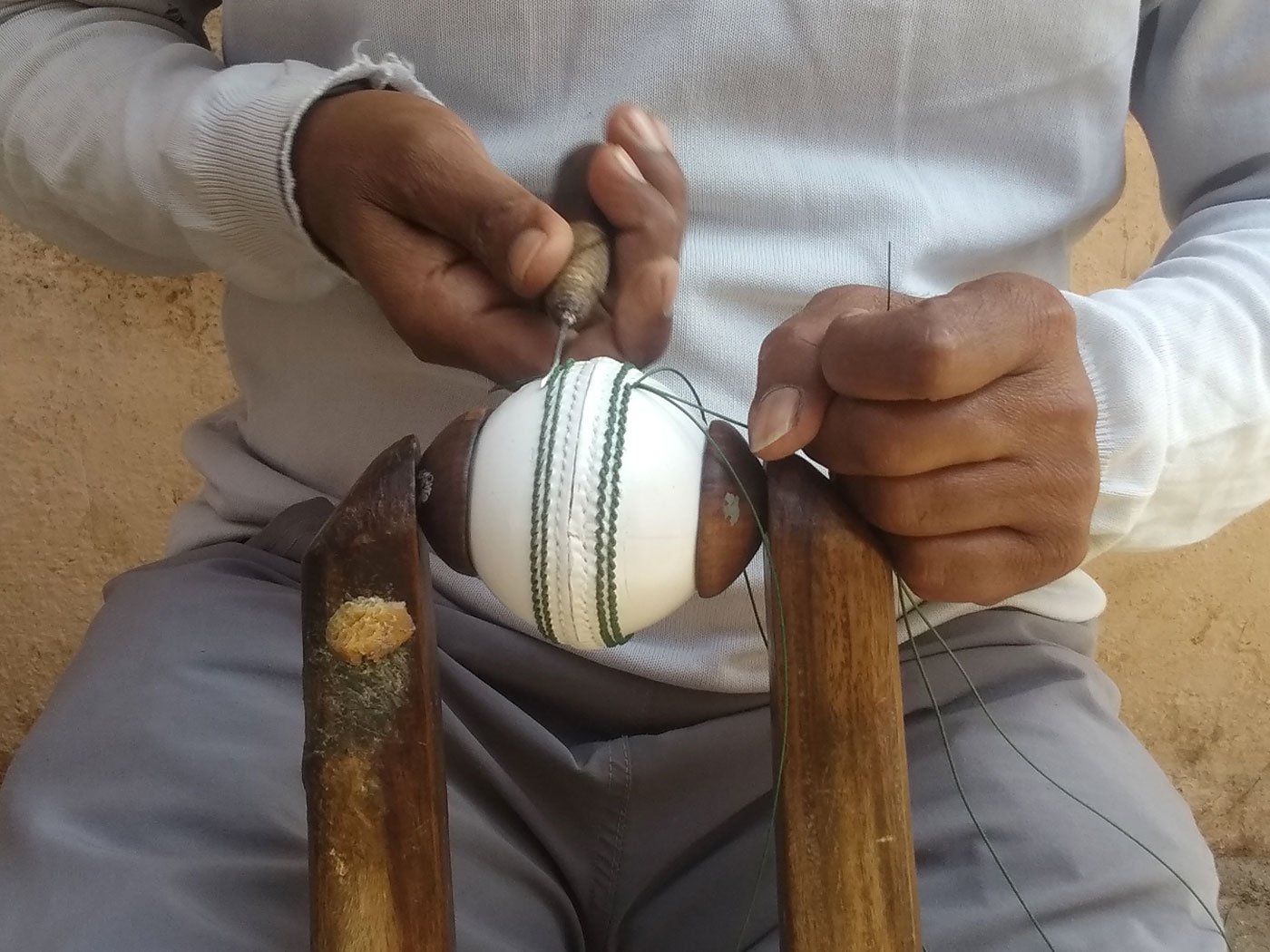
A karigar only moves to seam stitching after years of mastering the other routines. Pappan, 45, (left) must estimate correctly where to poke holes and space them accurately. It takes 80 stitches to makes holes for the best quality balls, and it can take a karigar more than 30 minutes to stitch four parallel rows of seam
“Spinner ho ya fast bowler, dono seam ke sahare hi gend phenkte hain [Be it a spinner or a fast bowler, both use the seam to deliver a ball],” Dharam adds. Once the seam stitches are complete, the protruding seam on the ball is hand pressed, and then the ball is lacquered and stamped. “ Khiladi kya pahchante hain? Sirf chamakti hui gend, sone ki muhar ke saath [What does the cricketer recognise? Only a shining ball with a golden stamp].”
“ Cricket ball ki ek khaas baat bataiye [Tell me what makes cricket balls special?]” Madan asks.
“ It is the only game in which formats have changed,” he says, “lekin bananewala aur banane ki takneek, tareeqa aur cheezein bilkul nahi badaleen [but the ball maker, and the technique, process, and materials in production have not changed at all].
On an average, 200 balls can be manufactured by Madan’s karigars in a day. To make one ball or a batch of balls, it takes around 2 weeks. From processing leather to the finished ball, “the skills of at least 11 karigars are needed, just like 11 cricketers make a team,” says Madan, smiling at his own analogy.
“Par khel ka asli karigar toh khiladi hi hove hai [But it is only the player who is considered the real craftsperson in sport] , ” he adds.
The reporter would like to thank Bharat Bhushan for his invaluable help with this story.
This story is supported by a fellowship from Mrinalini Mukherjee Foundation (MMF).